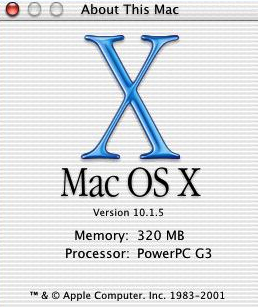Segments: Slices from the Macintosh Life
My First Mac
A few months ago I became a proud owner of a MacBook Pro running Snow Leopard. Before that I was getting by with a PowerBook G4 running Tiger, bought some four years ago. Being frugal and not always chasing the latest and greatest saves money and the frustration of owning machines that become outdated quickly. On the down side, my computing life got less pleasant as the hardware started to break down. Certain keys on the keyboard became unresponsive, the AC adapter was frayed, and the battery no longer charged to 100%. On the software side, certain software was released for the Leopard family only, and Web videos crawled painfully, like a slideshow.
After a short time with the new MacBook Pro, I wondered how I ever got anything done with the PowerBook G4. On its own, my mind wandered back to my first Mac, a PowerBook G3 “Wall Street.” Heavy, with a small hard drive, fueled by Mac OS 9, and lacking many of today’s amenities, how did I ever get anything done back then?
It has been so long that I cannot even remember the year I finally owned a Mac. It was some time after June 1997 and before October 1999. I was working as the sole tech support person for a small department at a Big Five accounting firm. Even though some of my client base were programmers—i.e., computer-literate people who required less hand-holding—having to deal with Windows 95 was still a daunting challenge. At home I had a Packard Bell PC, and it was no walk in the park using it either. So I would troubleshoot computers eight hours a day at work, then on my own time spend more time battling registry corruptions and overwritten DLL files.
I had already experienced the Mac platform from two previous jobs and especially enjoyed using FileMaker Pro. I was using the DOS-based dBASE and then graduated to Microsoft Access in Windows 95, but FileMaker Pro blew them both away. I did not care about Access’ ability to connect to larger SQL databases or its SQL querying prowess. I was ready to switch to the Mac platform.
Back then, in the late 1990s, laptops were still a big deal. At the accounting firm, for example, there were only a few laptops floating about. People had to sign up to use them briefly. Everyone worked on desktop computers. I was living in a cramped place, so naturally I also leaned toward laptops. The teardrop iMac of the day took less space than the traditional desktop with CRT monitor, but the keyboard and puck mouse would require some additional space. A laptop was the natural choice.

My first love in the Mac universe.
Twelve years ago, I had no problem recalling the specs on the PowerBook G3. These days, I only remember that it is a Wall Street model. It still works, so I now know that it runs at 266 MHz. It has 320 MB of RAM, but I know that is not the original. I do remember dropping it off at Tekserv to have the memory upgraded. When the hard drive died, I got a 12 GB replacement drive from Other World Computing and did the change myself. I love how the keyboard comes off easily to grant access to the hard drive.
Hot-swapping was, and still is, a great feature on the PowerBook G3. The default hot-swappable items are the battery on the left and the CD-ROM drive on the right. The Removable Media War at the time involved everyone trying to unseat Iomega’s Zip drive. I sided with “everyone” and bought the hot-swappable 120 MB SuperDisk from Imation. (On the drive itself, the maker is identified as VST Technologies.) One major selling point for the SuperDisk was that it could do double duty as a floppy disk drive. It was a slooow drive, but it got the job done. Eventually, I ended up with a Zip 250 external USB drive.

Back in the late 1990s, ADB and SCSI ports were still the norm.

Like a first child, the PowerBook G3 was showered with expansions like USB and FireWire.
Like having a first child, I bought lots of extra hardware for the PowerBook G3. In no particular order, they included: a PC Card USB adapter; a PC Card FireWire adapter; a FireWire CD-RW burner that was half the size of the PowerBook G3 itself; a $99 special cable to connect the PowerBook G3’s ADB printer port to the parallel port on an HP LJ 4L; a $50 SCSI cable, bought from DataVision (Fifth Ave. and 39th Street) so I could use the 1 GB Jaz drive I originally bought for use with the 486 Packard Bell PC. The battery had to be replaced, and then even the second battery died.

Compared to the trackpads found on 2009 MacBooks, the PowerBook G3’s trackpad is tiny.
On the software front, I upgraded the OS once to 9.2.2 and ended at OS X 10.1.5. Eudora Light was my e-mail client, Roxio burnt backup CDs or CD-RWs for me, and I tried out many browsers, including Netscape Navigator and Camino.

Mac OS X 10.1.5 was the highest I got the PowerBook G3 upgraded to.
Sometime in 2001, possibly with great influence by Mac OS X’s ever-greater demands, I got a domed iMac G4, and the PowerBook G3 finally got retired. Four years of life is a long duration in computer time.
Also in This Series
- About My Particular Macintoshes · May 2012
- From the Darkest Hour · May 2012
- Shrinking Into an Expanding World · May 2012
- Growing Up With Apple · May 2012
- Recollections of ATPM by the Plucky Comic Relief · May 2012
- Making the Leap · March 2012
- Digital > Analog > Digital · February 2012
- An Achievable Dream · February 2012
- Smart Move? · February 2012
- Complete Archive
Reader Comments (3)
There was a single 128k floppy drive, no hard drive. An app plus the files of work done with the app all fit on the single 128k disk. Attaching a second floppy drive upped the ante considerably. Every few years since then I've upgraded when the improvements became compelling enough. Typing this on a PowerBook G4, heavily customized. Maybe a new Mac next year.
I found a PowerBook G3 Wall Street just before it's last journey in the garbage can. It works fine except it doesn't have a battery, so it works only wired to the sector. As I don't have the wifi, I use the ethernet connector or my MacBook Pro with a cross cable, so the G3 can also access to its DVD drive.
I recall how, in the beginning, computer magazines printed program code that one had to spend a long time entering before running (usually a game), but it was educational. One saw a program's guts and learned how to modify it. Upgrading to 32 K was heaven. Yes, I said K! It was also a thrill to install a chip that gave my characters true descenders, and a CP/M card that took my text lines past the 40character limit. I wish I could include a couple of photos from those days.
Add A Comment